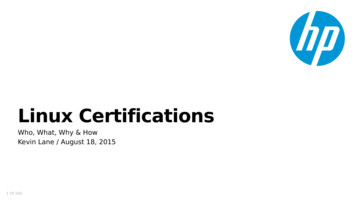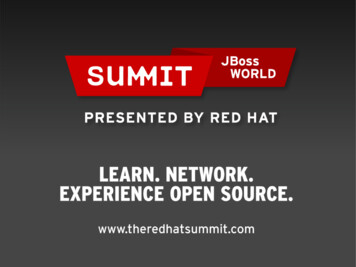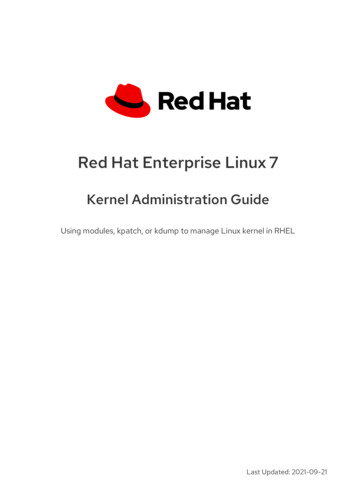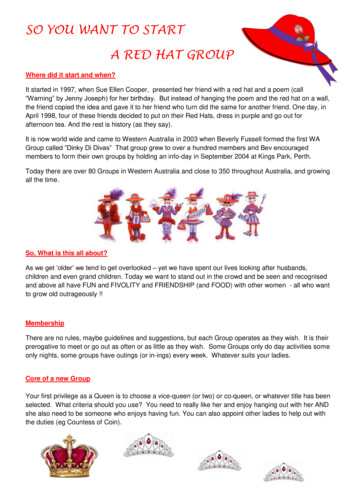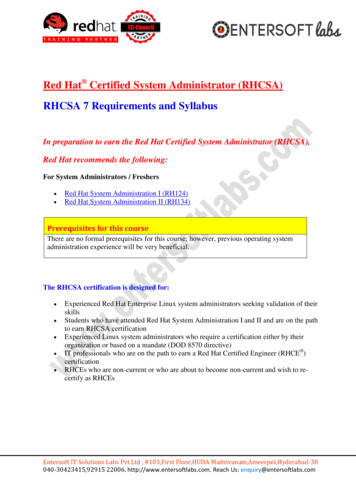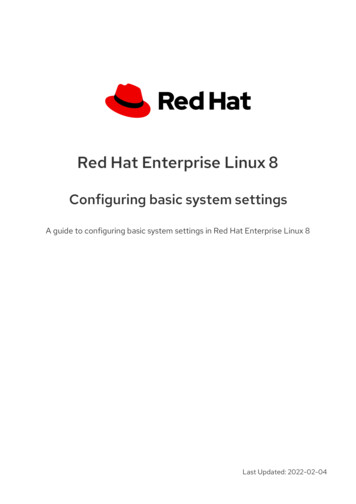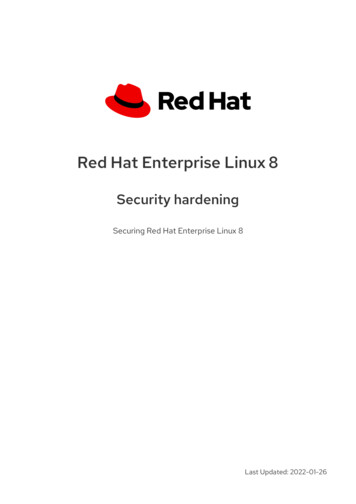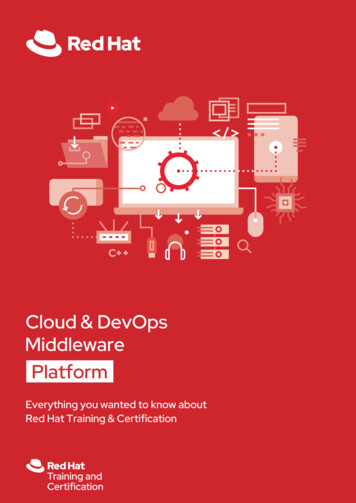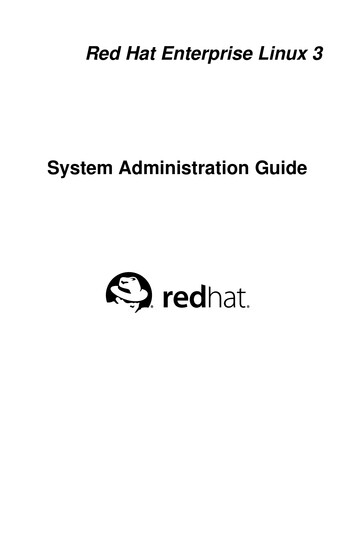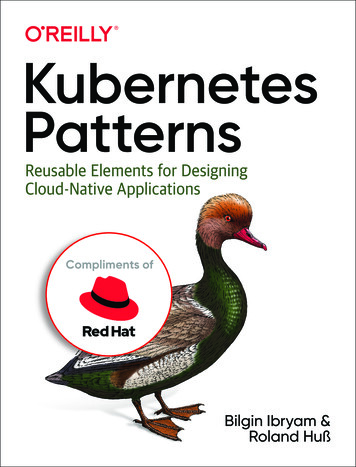
Transcription
KubernetesPatternsReusable Elements for DesigningCloud-Native ApplicationsCompliments ofBilgin Ibryam &Roland Huß
Build smarter.Ship faster.To make the most of the cloud, IT needs to approachapplications in new ways. Cloud-native developmentmeans packaging with containers, adopting modernarchitectures, and using agile techniques.Red Hat can help you arrange your people, processes,and technologies to build cloud-ready apps. See how atredhat.com/cloud-native-development.Copyright 2019 Red Hat, Inc. Red Hat and the Red Hat logo are trademarksor registered trademarks of Red Hat, Inc., in the U.S. and other countries.Hybrid Cloud Cloud-Native DevelopmentAutomation IT Optimization Agile Integration
Kubernetes PatternsReusable Elements for DesigningCloud-Native ApplicationsBilgin Ibryam and Roland HußBeijingBoston Farnham SebastopolTokyo
Kubernetes Patternsby Bilgin Ibryam and Roland HußCopyright 2019 Bilgin Ibryam and Roland Huß. All rights reserved.Printed in the United States of America.Published by O’Reilly Media, Inc., 1005 Gravenstein Highway North, Sebastopol, CA 95472.O’Reilly books may be purchased for educational, business, or sales promotional use. Online editions arealso available for most titles (http://oreilly.com). For more information, contact our corporate/institutionalsales department: 800-998-9938 or corporate@oreilly.com.Acquisitions Editor: John DevinsDevelopment Editor: Virginia WilsonProduction Editor: Katherine TozerCopyeditor: Christine EdwardsProofreader: Sharon WilkeyMay 2019:Indexer: Judith McConvilleInterior Designer: David FutatoCover Designer: Karen MontgomeryIllustrator: Rebecca DemarestFirst EditionRevision History for the First Edition2019-04-04:First ReleaseSee https://www.oreilly.com/catalog/errata.csp?isbn 9781492050285 for release details.This work is part of a collaboration between O’Reilly and Red Hat. See our statement of editorial inde‐pendence.The O’Reilly logo is a registered trademark of O’Reilly Media, Inc. Kubernetes Patterns, the cover image,and related trade dress are trademarks of O’Reilly Media, Inc.The views expressed in this work are those of the authors, and do not represent the publisher’s views.While the publisher and the authors have used good faith efforts to ensure that the information andinstructions contained in this work are accurate, the publisher and the authors disclaim all responsibilityfor errors or omissions, including without limitation responsibility for damages resulting from the use ofor reliance on this work. Use of the information and instructions contained in this work is at your ownrisk. If any code samples or other technology this work contains or describes is subject to open sourcelicenses or the intellectual property rights of others, it is your responsibility to ensure that your usethereof complies with such licenses and/or rights.978-1-492-07665-0[LSI]
Table of ContentsForeword. . . . . . . . . . . . . . . . . . . . . . . . . . . . . . . . . . . . . . . . . . . . . . . . . . . . . . . . . . . . . . . . . . . . . ixPreface. . . . . . . . . . . . . . . . . . . . . . . . . . . . . . . . . . . . . . . . . . . . . . . . . . . . . . . . . . . . . . . . . . . . . . . xi1. Introduction. . . . . . . . . . . . . . . . . . . . . . . . . . . . . . . . . . . . . . . . . . . . . . . . . . . . . . . . . . . . . . . . 1The Path to Cloud NativeDistributed amespacesDiscussionMore InformationPart I.134577991112Foundational Patterns2. Predictable Demands. . . . . . . . . . . . . . . . . . . . . . . . . . . . . . . . . . . . . . . . . . . . . . . . . . . . . . 15ProblemSolutionRuntime DependenciesResource ProfilesPod PriorityProject ResourcesCapacity Planning15161618202222iii
DiscussionMore Information23243. Declarative Deployment. . . . . . . . . . . . . . . . . . . . . . . . . . . . . . . . . . . . . . . . . . . . . . . . . . . . 25ProblemSolutionRolling DeploymentFixed DeploymentBlue-Green ReleaseCanary ReleaseDiscussionMore Information25252729303031334. Health Probe. . . . . . . . . . . . . . . . . . . . . . . . . . . . . . . . . . . . . . . . . . . . . . . . . . . . . . . . . . . . . 35ProblemSolutionProcess Health ChecksLiveness ProbesReadiness ProbesDiscussionMore Information353536363738405. Managed Lifecycle. . . . . . . . . . . . . . . . . . . . . . . . . . . . . . . . . . . . . . . . . . . . . . . . . . . . . . . . . 41ProblemSolutionSIGTERM SignalSIGKILL SignalPoststart HookPrestop HookOther Lifecycle ControlsDiscussionMore Information4141424243444546466. Automated Placement. . . . . . . . . . . . . . . . . . . . . . . . . . . . . . . . . . . . . . . . . . . . . . . . . . . . . 47ProblemSolutionAvailable Node ResourcesContainer Resource DemandsPlacement PoliciesScheduling ProcessNode Affinityiv Table of Contents47474849495051
Pod Affinity and AntiaffinityTaints and TolerationsDiscussionMore Information52545759Part II. Behavioral Patterns7. Batch Job. . . . . . . . . . . . . . . . . . . . . . . . . . . . . . . . . . . . . . . . . . . . . . . . . . . . . . . . . . . . . . . . 63ProblemSolutionDiscussionMore Information636467688. Periodic Job. . . . . . . . . . . . . . . . . . . . . . . . . . . . . . . . . . . . . . . . . . . . . . . . . . . . . . . . . . . . . . 69ProblemSolutionDiscussionMore Information697071729. Daemon Service. . . . . . . . . . . . . . . . . . . . . . . . . . . . . . . . . . . . . . . . . . . . . . . . . . . . . . . . . . . 73ProblemSolutionDiscussionMore Information7374767710. Singleton Service. . . . . . . . . . . . . . . . . . . . . . . . . . . . . . . . . . . . . . . . . . . . . . . . . . . . . . . . . . 79ProblemSolutionOut-of-Application LockingIn-Application LockingPod Disruption BudgetDiscussionMore Information7980808284858611. Stateful Service. . . . . . . . . . . . . . . . . . . . . . . . . . . . . . . . . . . . . . . . . . . . . . . . . . . . . . . . . . . 8989Table of Contents v
Other alityOther FeaturesDiscussionMore information89909192949495969712. Service Discovery. . . . . . . . . . . . . . . . . . . . . . . . . . . . . . . . . . . . . . . . . . . . . . . . . . . . . . . . . . 99ProblemSolutionInternal Service DiscoveryManual Service DiscoveryService Discovery from Outside the ClusterApplication Layer Service DiscoveryDiscussionMore Information9910010110410711111311513. Self Awareness. . . . . . . . . . . . . . . . . . . . . . . . . . . . . . . . . . . . . . . . . . . . . . . . . . . . . . . . . . 117ProblemSolutionDiscussionMore Information117117121121Part III. Structural Patterns14. Init Container. . . . . . . . . . . . . . . . . . . . . . . . . . . . . . . . . . . . . . . . . . . . . . . . . . . . . . . . . . . . 125ProblemSolutionDiscussionMore Information12512613013015. Sidecar. . . . . . . . . . . . . . . . . . . . . . . . . . . . . . . . . . . . . . . . . . . . . . . . . . . . . . . . . . . . . . . . . 131ProblemSolutionDiscussionMore Informationvi Table of Contents131132134134
16. Adapter. . . . . . . . . . . . . . . . . . . . . . . . . . . . . . . . . . . . . . . . . . . . . . . . . . . . . . . . . . . . . . . . . 135ProblemSolutionDiscussionMore Information13513513813817. Ambassador. . . . . . . . . . . . . . . . . . . . . . . . . . . . . . . . . . . . . . . . . . . . . . . . . . . . . . . . . . . . . 139ProblemSolutionDiscussionMore Information139139141142Part IV. Configuration Patterns18. EnvVar Configuration. . . . . . . . . . . . . . . . . . . . . . . . . . . . . . . . . . . . . . . . . . . . . . . . . . . . . 145ProblemSolutionDiscussionMore Information14514514814919. Configuration Resource. . . . . . . . . . . . . . . . . . . . . . . . . . . . . . . . . . . . . . . . . . . . . . . . . . . 151ProblemSolutionDiscussionMore Information15115115615620. Immutable Configuration. . . . . . . . . . . . . . . . . . . . . . . . . . . . . . . . . . . . . . . . . . . . . . . . . 157ProblemSolutionDocker VolumesKubernetes Init ContainersOpenShift TemplatesDiscussionMore Information15715715815916216316421. Configuration Template. . . . . . . . . . . . . . . . . . . . . . . . . . . . . . . . . . . . . . . . . . . . . . . . . . . 165ProblemSolutionDiscussionMore Information165165170171Table of Contents vii
Part V.Advanced Patterns22. Controller. . . . . . . . . . . . . . . . . . . . . . . . . . . . . . . . . . . . . . . . . . . . . . . . . . . . . . . . . . . . . . . 175ProblemSolutionDiscussionMore Information17517618618723. Operator. . . . . . . . . . . . . . . . . . . . . . . . . . . . . . . . . . . . . . . . . . . . . . . . . . . . . . . . . . . . . . . . 189ProblemSolutionCustom Resource DefinitionsController and Operator ClassificationOperator Development and DeploymentExampleDiscussionMore Information18919019019219519720120224. Elastic Scale. . . . . . . . . . . . . . . . . . . . . . . . . . . . . . . . . . . . . . . . . . . . . . . . . . . . . . . . . . . . . 203ProblemSolutionManual Horizontal ScalingHorizontal Pod AutoscalingVertical Pod AutoscalingCluster AutoscalingScaling LevelsDiscussionMore Information20320420420521021321621921925. Image Builder. . . . . . . . . . . . . . . . . . . . . . . . . . . . . . . . . . . . . . . . . . . . . . . . . . . . . . . . . . . 221ProblemSolutionOpenShift BuildKnative BuildDiscussionMore Information221222223230234235Afterword. . . . . . . . . . . . . . . . . . . . . . . . . . . . . . . . . . . . . . . . . . . . . . . . . . . . . . . . . . . . . . . . . . . 237Index. . . . . . . . . . . . . . . . . . . . . . . . . . . . . . . . . . . . . . . . . . . . . . . . . . . . . . . . . . . . . . . . . . . . . . . 239viii Table of Contents
ForewordWhen Craig, Joe, and I started Kubernetes nearly five years ago, I think we all recog‐nized its power to transform the way the world developed and delivered software. Idon’t think we knew, or even hoped to believe, how quickly this transformationwould come. Kubernetes is now the foundation for the development of portable, reli‐able systems spanning the major public clouds, private clouds, and bare-metal envi‐ronments. However, even as Kubernetes has become ubiquitous to the point whereyou can spin up a cluster in the cloud in less than five minutes, it is still far less obvi‐ous to determine where to go once you have created that cluster. It is fantastic that wehave seen such significant strides forward in the operationalization of Kubernetesitself, but it is only a part of the solution. It is the foundation on which applicationswill be built, and it provides a large library of APIs and tools for building these appli‐cations, but it does little to provide the application architect or developer with anyhints or guidance for how these various pieces can be combined into a complete, reli‐able system that satisfies their business needs and goals.Although the necessary perspective and experience for what to do with your Kuber‐netes cluster can be achieved through past experience with similar systems, or viatrial and error, this is expensive both in terms of time and the quality of systemsdelivered to our end users. When you are starting to deliver mission-critical serviceson top of a system like Kubernetes, learning your way via trial and error simply takestoo much time and results in very real problems of downtime and disruption.This then is why Bilgin and Roland’s book is so valuable. Kubernetes Patterns enablesyou to learn from the previous experience that we have encoded into the APIs andtools that make up Kubernetes. Kubernetes is the by-product of the community’sexperience building and delivering many different, reliable distributed systems in avariety of different environments. Each object and capability added to Kubernetesrepresents a foundational tool that has been designed and purpose-built to solve aspecific need for the software designer. This book explains how the concepts inKubernetes solve real-world problems and how to adapt and use these concepts tobuild the system that you are working on today.ix
In developing Kubernetes, we always said that our North Star was making the devel‐opment of distributed systems a CS 101 exercise. If we have managed to achieve thatgoal successfully, it is books like this one that are the textbooks for such a class. Bilginand Roland have captured the essential tools of the Kubernetes developer and distil‐led them into segments that are easy to approach and consume. As you finish thisbook, you will become aware not just of the components available to you in Kuber‐netes, but also the “why” and “how” of building systems with those components.— Brendan Burns,Cofounder, Kubernetesx Foreword
PrefaceWith the evolution of microservices and containers in recent years, the way wedesign, develop, and run software has changed significantly. Today’s applications areoptimized for scalability, elasticity, failure, and speed of change. Driven by new prin‐ciples, these modern architectures require a different set of patterns and practices.This book aims to help developers create cloud-native applications with Kubernetesas a runtime platform. First, let’s take a brief look at the two primary ingredients ofthis book: Kubernetes and design patterns.KubernetesKubernetes is a container orchestration platform. The origin of Kubernetes lies some‐where in the Google data centers where Google’s internal container orchestrationplatform, Borg, was born. Google used Borg for many years to run its applications. In2014, Google decided to transfer its experience with Borg into a new open sourceproject called “Kubernetes” (Greek for “helmsman” or “pilot”), and in 2015, it becamethe first project donated to the newly founded Cloud Native Computing Foundation(CNCF).Right from the start, Kubernetes gained a whole community of users, and the numberof contributors grew at an incredibly fast pace. Today, Kubernetes is considered oneof the most active projects on GitHub. It is probably fair to claim that at the time ofthis writing, Kubernetes is the most commonly used and feature-rich containerorchestration platform. Kubernetes also forms the foundation of other platforms builton top of it. The most prominent of those Platform-as-a-Service systems is Red HatOpenShift, which provides various additional capabilities to Kubernetes, includingways to build applications within the platform. These are only some of the reasons wechose Kubernetes as the reference platform for the cloud-native patterns in this book.This book assumes you have some basic knowledge of Kubernetes. In Chapter 1, werecapitulate the core Kubernetes concepts and lay out the foundation for the follow‐ing patterns.xi
Design PatternsThe concept of design patterns dates back to the 1970s and from the field of architec‐ture. Christopher Alexander, an architect and system theorist, and his team publishedthe groundbreaking A Pattern Language (Oxford University Press) in 1977, whichdescribes architectural patterns for creating towns, buildings, and other constructionprojects. Sometime later this idea was adopted by the newly formed software indus‐try. The most famous book in this area is Design Patterns—Elements of ReusableObject-Oriented Software by Erich Gamma, Richard Helm, Ralph Johnson, and JohnVlissides—the Gang of Four (Addison-Wesley). When we talk about the famous Sin‐gleton, Factories, or Delegation patterns, it’s because of this defining work. Manyother great pattern books have been written since then for various fields with differ‐ent levels of granularity, like Enterprise Integration Patterns by Gregor Hohpe andBobby Woolf (Addison-Wesley) or Patterns of Enterprise Application Architecture byMartin Fowler (Addison-Wesley).In short, a pattern describes a repeatable solution to a problem.1 It is different from arecipe because instead of giving step-by-step instructions to solving a problem, a pat‐tern provides a blueprint for solving a whole class of similar problems. For example,the Alexandrian pattern “Beer Hall” describes how public drinking halls should beconstructed where “strangers and friends are drinking companions” and not “anchorsof the lonely.” All halls built after this pattern look different, but share common char‐acteristics such as open alcoves for groups of four to eight and a place where a hun‐dred people can meet with beverages, music, and other activities.However, a pattern does more than provide a solution. It is also about forming a lan‐guage. The unique pattern names form a dense, noun-centric language in which eachpattern carries a unique name. When this language is established, these names auto‐matically evoke similar mental representations when people speak about these pat‐terns. For example, when we talk about a table, anyone speaking English assumes weare talking about a piece of wood with four legs and a top on which you can putthings. The same thing happens in software engineering when we talk about a “fac‐tory.” In an object-oriented programming language context, we immediately associatewith a “factory” an object that produces other objects. Because we immediately knowthe solution behind the pattern, we can move on to tackle yet unsolved problems.1 Christopher Alexander and his team defined the original meaning in the context of architecture as follows:“Each pattern describes a problem which occurs over and over again in our environment, and then describesthe core of the solution to that problem, in such a way that you can use this solution a million times over,without ever doing it the same way twice.” (A Pattern Language, Christopher Alexander et al., 1977, p. x). Wethink this definition works for the patterns we describe in this book, except that we probably don’t have asmuch variability in our solutions.xii Preface
There are also other characteristics of a pattern language. Patterns are interconnectedand can overlap so that together, they cover most of the problem space. Also, asalready laid out in the original A Pattern Language, patterns do not have the samelevel of granularity and scope. More general patterns cover an extensive problemspace and provide rough guidance on how to solve the problem. Granular patternshave a very concrete solution proposal but are not as widely applicable. This bookcontains all sort of patterns, and many patterns reference other patterns or may eveninclude other patterns as part of the solution.Another feature of patterns is that they follow a rigid format. However, each authordefines a different format, and unfortunately there is no common standard for theway patterns should be laid out. Martin Fowler gives an excellent overview of the for‐mats used for pattern languages in Writing Software Patterns.How This Book Is StructuredWe chose a simple pattern format for this book. We do not follow any particular pat‐tern description language. For each pattern, we use the following structure:NameEach pattern carries a name, which is also the chapter’s title. The name is the cen‐ter of the pattern’s language.ProblemThis section gives the broader context and describes the pattern space in detail.SolutionThis section is about how the pattern solves the problem in a Kubernetes-specificway. This section also contains cross-references to other patterns that are eitherrelated or part of the given pattern.DiscussionA discussion about the advantages and disadvantages of the solution for thegiven context follows.More InformationThis final section contains additional information sources related to the pattern.We organized the patterns of this book as follows: Part I, Foundational Patterns, covers the core concepts of Kubernetes. These arethe underlying principles and practices for building container-based cloud-nativeapplications.Preface xiii
Part II, Behavioral Patterns, describes patterns that sit on top of the foundationalpatterns and add finer-grained concepts for managing various types of containerand platform interactions. Part III, Structural Patterns, contains patterns related to organizing containerswithin a Pod, which is the atom of the Kubernetes platform. Part IV, Configuration Patterns, gives insight into the various ways applicationconfiguration can be handled in Kubernetes. These are very granular patterns,including concrete recipes for connecting applications to their configuration. Part V, Advanced Patterns, is a collection of advanced concepts, such as how theplatform itself can be extended or how to build container images directly withinthe cluster.A pattern might not always fit into one category alone. Depending on the context, thesame pattern might fit into several categories. Every pattern chapter is self-contained,and you can read chapters in isolation and in any order.Who This Book Is ForThis book is for developers who want to design and develop cloud-native applicationsfor the Kubernetes platform. It is most suitable for readers who have some basicfamiliarity with containers and Kubernetes concepts, and want to take it to the nextlevel. However, you don’t need to know the low-level details of Kubernetes to under‐stand the use cases and patterns. Architects, technical consultants, and developerswill all benefit from the repeatable patterns described here.This book is based on use cases and lessons learned from real-world projects. Wewant to help you create better cloud-native applications—not reinvent the wheel.What You Will LearnThere’s a lot to discover in this book. Some of the patterns may read like excerptsfrom a Kubernetes manual at first glance, but upon closer look you’ll see the patternsare presented from a conceptual angle not found in other books on the topic. Otherpatterns are explained with a different approach, with detailed guidelines for veryconcrete problems, as in “Configuration Patterns” in Part IV.Regardless of the pattern granularity, you will learn everything Kubernetes offers foreach particular pattern, with plenty of examples to illustrate the concepts. All theseexamples have been tested, and we tell you how to get the full source code in “UsingCode Examples”.xiv Preface
Before we start to dive in, let’s briefly look at what this book is not: This book is not a guide on how to set up a Kubernetes cluster itself. Every pat‐tern and every example assumes you have Kubernetes up and running. You haveseveral options for trying out the examples. If you are interested in learning howto set up a Kubernetes cluster, we recommend Managing Kubernetes by BrendanBurns and Craig Tracey (O’Reilly). Also, the Kubernetes Cookbook by MichaelHausenblas and Sébastien Goasguen (O’Reilly) has recipes for setting up aKubernetes cluster from scratch. This book is not an introduction to Kubernetes, nor a reference manual. Wetouch on many Kubernetes features and explain them in some detail, but we arefocusing on the concepts behind those features. Chapter 1, Introduction, offers abrief refresher on Kubernetes basics. If you are looking for a comprehensive bookon how to use Kubernetes, we highly recommend Kubernetes in Action by MarkoLukša (Manning Publications).The book is written in a relaxed style, and is similar to a series of essays that can beread independently.ConventionsAs mentioned, patterns form a kind of simple, interconnected language. To empha‐size this web of patterns, each pattern is capitalized in italics, (e.g., Sidecar). When apattern is named like a Kubernetes core concept (like Init Container or Controller), weuse this specific formatting only when we directly reference the pattern itself. Whereit makes sense, we also interlink pattern chapters for ease of navigation.We also use the following conventions: Everything you can type in a shell or editor is rendered in fixed font width. Kubernetes resource names are always rendered in uppercase (e.g., Pod). If theresource is a combined name like ConfigMap, we keep it like this in favor of themore natural “config map” for clarity and to make it clear that it refers to aKubernetes concept. Sometimes a Kubernetes resource name is identical to a common concept like“service” or “node”. In these cases we use the resource name format only whenreferring to the resource itself.Preface xv
Using Code ExamplesEvery pattern is backed with fully executable examples, which you can find on theaccompanying web page. You can find the link to each pattern’s example in the “MoreInformation” section of each chapter.The “More Information” section also contains many links to further informationrelated to the pattern. We keep these lists updated in the example repository. Changesto the link collections will also be posted on Twitter.The source code for all examples in this book is available at GitHub. The repositoryand the website also have pointers and instructions on how to get a Kubernetes clus‐ter to try out the examples. When you go through the examples, please also have alook into the provided resource files. They contain many useful comments that helpfurther in understanding the example code.Many examples use a REST service called random-generator that returns randomnumbers when called. It is uniquely crafted for playing well with the examples of thisbook. Its source can be found at GitHub as well, and its container image k8spatterns/random-generator is hosted on Docker Hub.For describing resource fields, we use a JSON path notation. For example, .spec.replicas points to the replicas field of the resource’s spec section.If you find an issue in the example code or documentation or if you have a question,don’t hesitate to open a ticket in the GitHub issue tracker. We monitor these GitHubissues and are happy to answer any questions over there.All example code is distributed under the Creative Commons Attribution 4.0 (CC BY4.0) license. The code is free to use, and you are free to share and adapt it for com‐mercial and noncommercial projects. However, you should give attribution back tothis book if you copy or redistribute the material.This attribution can be either a reference to the book including title, author, pub‐lisher, and ISBN, as in “Kubernetes Patterns by Bilgin Ibryam and Roland Huß(O’Reilly). Copyright 2019 Bilgin Ibryam and Roland Huß, 978-1-492-05028-5.”Alternatively, add a link back to the accompanying website along with a copyrightnotice and link to the license.We love code contributions, too! If you think we can improve our examples, we arehappy to hear from you. Just open a GitHub issue or create a pull request, and let’sstart a conversation.xvi Preface
O’Reilly Online LearningFor almost 40 years, O’Reilly Media has provided technologyand business training, knowledge, and insight to help compa‐nies succeed.Our unique network of experts and innovators share their knowledge and expertisethrough books, articles, conferences, and our online learning platform. O’Reilly’sonline learning platform gives you on-demand access to live training courses, indepth learning paths, interactive coding environments, and a vast collection of textand video from O’Reilly and 200 other publishers. For more information, pleasevisit http://oreilly.com.How to Contact UsPlease address comments and questions concerning this book to the publisher:O’Reilly Media, Inc.1005 Gravenstein Highway NorthSebastopol, CA 95472800-998-9938 (in the United States or Canada)707-829-0515 (international or local)707-829-0104 (fax)We have a web page for this book where we list errata, examples, and additionalinformation. You can access this page at https://oreil.ly/kubernetes patterns.To comment or ask technical questions about this book, email bookques‐tions@oreilly.com.For more information about our books, courses, conferences, and news, see our web‐site at http://www.oreilly.com.Find us on Facebook: http://facebook.com/oreillyFollow us on Twitter: http://twitter.com/oreillymediaWatch us on YouTube: http://www.youtube.com/oreillymediaFollow the authors on Twitter: https://twitter.com/bibryam, https://twitter.com/ro14ndFind the authors on GitHub: https://github.com/bibryam, https://github.com/rhussFollow their blogs: https://www.ofbizian.com, https://ro14nd.dePreface xvii
AcknowledgmentsCreating this book was a long journey spanning over two years, and we want to thankall of our reviewers who kept us on the right track. Special kudos go out to PaoloAntinori and Andrea Tarocchi for helping us through the whole journey. Big thanksalso to Marko Lukša, Brandon Philips, Michael Hüttermann, Brian Gracely, AndrewBlock, Jiri Kremser, Tobias Schneck, and Rick Wagner, who supported us with theirexpertise and advices. Last, but not least, big thanks to our editors Virginia Wilson,John Devins, Katherine Tozer, Christina Edwards and all the awesome folks atO’Reilly for helping us push this book over the finish line.xviii Preface
CHAPTER 1IntroductionIn this introductory chapter, we set the scene for the rest of the book by explaining afew of the core Kubernetes concepts used for designing and implementing containerbased cloud-native applications. Understanding these new abstractions, and therelated principles and patterns from this book, are key to building distributed appli‐cations made automatable by cloud-native platforms.This chapter is not a prerequisite for understanding the patterns described later.Readers familiar with Kubernetes concepts can skip it and jump straight into the pat‐tern category of interest.The Path to Cloud NativeThe most popular application architecture on the cloud-native platforms such asKubernetes is the microservices style. This software development technique tacklessoftware complexity through modularization of business capabilities and tradingdevelopment complexity for operational complexity.As part of the microservices movement, there is a significant amount of theory andsupplemental techniques for creating microservices from scratch or for splittingmonoliths into microservices. Most of these practices
project called “Kubernetes” (Greek for “helmsman” or “pilot”), and in 2015, it became the first project donated to the newly founded Cloud Native Computing Foundation (CNCF). Right from the start, Kubernetes gained a whole community of users, and the number of contributors


